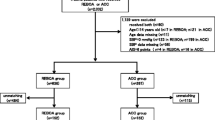Abstract
Background
Resuscitative endovascular balloon occlusion of the aorta (REBOA) has the potential to be an alternative to open aortic cross-clamping (ACC). However, its practical indication remains unknown. We examined the usage trend of REBOA and ACC in Japan for severe torso trauma and investigated whether these procedures were associated with the time of death distribution based on a large database from the Japan Trauma Data Bank (JTDB).
Methods
The JTDB from 2004 to 2014 was reviewed. Eligible patients were restricted to those with severe torso trauma, which was defined as an abbreviated injury scale score of ≥4. Patients were classified into groups according to the aortic occlusion procedures. The primary outcomes were the rates of REBOA and ACC use according to the clinical situation. We also evaluated whether the time of death distribution for the first 8 h differed based on these procedures.
Results
During the study period, a total of 21,533 patients met our inclusion criteria. Overall, REBOA was more commonly used than ACC for patients with severe torso trauma (2.8% vs 1.5%). However, ACC was more frequently used in cases of thoracic injury and cardiac arrest. Regarding the time of death distribution, the cumulative curve for death in REBOA cases was elevated much more slowly and mostly flat for the first 100 min.
Conclusions
REBOA is more commonly used compared to ACC for patients with severe torso trauma in Japan. Moreover, it appears that REBOA influences the time of death distribution in the hyperacute phase.



Similar content being viewed by others
References
Biffl WL, Fox CJ, Moore EE (2015) The role of REBOA in the control of exsanguinating torso hemorrhage. J Trauma Acute Care Surg 78(5):1054–1058
Pasley J, Cannon J, Glaser J, Polk T et al. (2017) Joint trauma system clinical practice guideline (JTS CPG), resuscitative endovascular balloon occlusion of the aorta (REBOA) for hemorrhagic shock (CPG ID: 38). http://prytimemedical.com/wp-content/uploads/2017/07/REBOA_-CPG_FINAL.pdf. Accessed 14 Dec 2018
Norii T, Crandall C, Terasaka Y (2015) Survival of severe blunt trauma patients treated with resuscitative endovascular balloon occlusion of the aorta compared with propensity score-adjusted untreated patients. J Trauma Acute Care Surg 78(4):721–728
Inoue J, Shiraishi A, Yoshiyuki A et al (2016) Resuscitative endovascular balloon occlusion of the aorta might be dangerous in patients with severe torso trauma: a propensity score analysis. J Trauma Acute Care Surg 80(4):559–566 (discussion 66–67)
Abe T, Uchida M, Nagata I et al (2016) Resuscitative endovascular balloon occlusion of the aorta versus aortic cross clamping among patients with critical trauma: a nationwide cohort study in Japan. Crit Care 20(1):400
Aso S, Matsui H, Fushimi K et al (2017) Resuscitative endovascular balloon occlusion of the aorta or resuscitative thoracotomy with aortic clamping for noncompressible torso hemorrhage: a retrospective nationwide study. J Trauma Acute Care Surg 82(5):910–914
Russo RM, Neff LP, Lamb CM et al (2016) Partial resuscitative endovascular balloon occlusion of the aorta in swine model of hemorrhagic shock. J Am Coll Surg 223(2):359–368
Morrison JJ, Ross JD, Rt Houston et al (2014) Use of resuscitative endovascular balloon occlusion of the aorta in a highly lethal model of noncompressible torso hemorrhage. Shock 41(2):130–137
Scott DJ, Eliason JL, Villamaria C et al (2013) A novel fluoroscopy-free, resuscitative endovascular aortic balloon occlusion system in a model of hemorrhagic shock. J Trauma Acute Care Surg 75(1):122–128
Markov NP, Percival TJ, Morrison JJ et al (2013) Physiologic tolerance of descending thoracic aortic balloon occlusion in a swine model of hemorrhagic shock. Surgery 153(6):848–856
White JM, Cannon JW, Stannard A et al (2011) Endovascular balloon occlusion of the aorta is superior to resuscitative thoracotomy with aortic clamping in a porcine model of hemorrhagic shock. Surgery 150(3):400–409
Brenner M, Teeter W, Hoehn M et al (2018) Use of resuscitative endovascular balloon occlusion of the aorta for proximal aortic control in patients with severe hemorrhage and arrest. JAMA Surg 153(2):130–135
Brenner M, Hoehn M, Pasley J et al (2014) Basic endovascular skills for trauma course: bridging the gap between endovascular techniques and the acute care surgeon. J Trauma Acute Care Surg 77(2):286–291
Rafieian-Kopaei M, Setorki M, Doudi M et al (2014) Atherosclerosis: process, indicators, risk factors and new hopes. Int J Prev Med 5(8):927–946
Author information
Authors and Affiliations
Contributions
SM, TA, TF, and KJ participated in the study design. SM and KH participated in the analysis and interpretation of data. SM and KS participated in drafting the article. TM critically revised the manuscript.
Corresponding author
Ethics declarations
Conflicts of interest
The authors declare that there is no conflict of interest.
Additional information
Publisher's Note
Springer Nature remains neutral with regard to jurisdictional claims in published maps and institutional affiliations.
Electronic supplementary material
Below is the link to the electronic supplementary material.
268_2019_4968_MOESM1_ESM.pptx
Appendix 1. Algorithm for torso hemorrhage control. EDT, emergency department resuscitative thoracotomy. Reproduced with permission from Lippincott, Williams & Wilkins. Source: Biffl WL, Fox CJ, Moore EE. The role of REBOA in the control of exsanguinating torso hemorrhage. J Trauma Acute Care Surg. 2015;78(5):1054-8. (PPTX 171 kb)
268_2019_4968_MOESM2_ESM.pptx
Appendix 2. Trends in REBOA and ACC for severe torso trauma. ACC, open aortic cross-clamping; REBOA, resuscitative endovascular balloon occlusion of the aorta (PPTX 41 kb)
268_2019_4968_MOESM6_ESM.pptx
Appendix 6. A. Intra-aortic occlusion balloon (IABO), MERA Tokyo, Japan. The 10-Fr sheath and vascular puncture set. B. Rescue Balloon, Tokai Medical Products, Aichi, Japan. The 7-Fr sheath and vascular puncture set. (PPTX 1948 kb)
Rights and permissions
About this article
Cite this article
Matsumoto, S., Hayashida, K., Akashi, T. et al. Resuscitative Endovascular Balloon Occlusion of the Aorta (REBOA) for Severe Torso Trauma in Japan: A Descriptive Study. World J Surg 43, 1700–1707 (2019). https://doi.org/10.1007/s00268-019-04968-2
Published:
Issue Date:
DOI: https://doi.org/10.1007/s00268-019-04968-2




